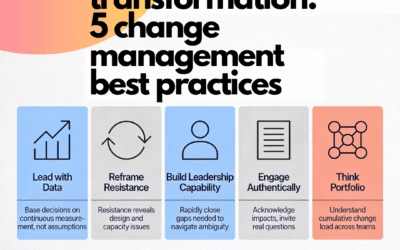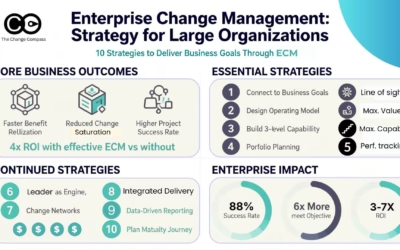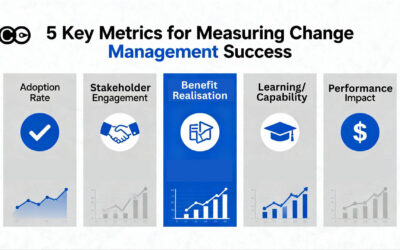In today’s fast-paced business environment, most organizations are engaged in numerous change initiatives, including organizational transformation, simultaneously. These initiatives might range from digital transformation efforts to restructuring, new product launches, or cultural shifts. For change management practitioners and leaders, the challenge is not only to ensure each initiative succeeds but also to align these efforts strategically to maximize overall business benefit. Let’s explore practical strategies for aligning multiple initiatives and measuring change adoption, providing actionable insights for change practitioners and leaders.
The Complexity of Multiple Change Initiatives
The complexity of managing multiple change initiatives lies in the potential for overlap, conflicting priorities, and resource strain. Each initiative, while aiming to deliver specific benefits, competes for attention, time, and resources. Moreover, when several initiatives target similar business outcomes, it becomes challenging to attribute success to any single effort. Most business units are only measuring a certain number of business metrics, and with a large number of initiatives there will bound to be overlaps. This makes it essential to adopt a strategic approach that ensures alignment and optimal resource utilisation.
One of the most critical aspects of managing multiple change initiatives is measuring the adoption of each change. This involves not only tracking how well each initiative is being implemented but also creating a clear and detailed plan to understand its impact on the organization. The following strategies can help you effectively measure change adoption across various initiatives:
1. Establish Common Metrics
Establishing common metrics across all change initiatives is a foundational step in ensuring that change adoption is measured consistently and effectively. Common metrics provide a standardized way to evaluate progress, compare the success of different initiatives, and gain a holistic view of the organization’s overall change efforts. This approach allows for “apples-to-apples” comparisons, enabling senior leaders to make informed decisions about resource allocation, prioritization, and potential adjustments needed to maximize business benefits.
By identifying and applying a set of core metrics consistently across all change initiatives, organizations can better track the adoption process, identify areas where additional support may be needed, and ultimately ensure that changes are embedded successfully and sustainably.
Here’s a deeper look at some of the common metrics that can be established (note that we take a holistic and strategic lense in ‘adoption’, and not limiting adoption to the end of the project):
Employee Awareness and Understanding of the Change
Employee awareness and understanding are the first critical steps in the change adoption process. Without a clear understanding of what the change entails, why it is happening, and how it will impact their work, employees may experience discomfort and are unlikely to fully embrace the change. Measuring awareness and understanding helps ensure that communication efforts are effective and that employees have the necessary information to begin adopting the change.
- Awareness Surveys: Regular surveys can be conducted to assess employees’ awareness of the change initiative. Questions can focus on whether employees are aware of the change, if they understand the reasons behind it, and if they can articulate the expected outcomes.
- Knowledge Assessments: Beyond awareness, knowledge assessments can help gauge how well employees understand the details of the change. This could involve quizzes, interactive sessions, or discussions that test their understanding of new processes, tools, or organizational structures.
- Communication Effectiveness: Track the effectiveness of communication campaigns through metrics such as email open rates, attendance at town halls or webinars, and engagement with internal communication platforms. High levels of engagement can indicate that employees are receiving and processing the information about the change.
Employee Engagement and Buy-in
Employee engagement and buy-in are essential for successful change adoption. If employees are not engaged or do not buy into the change, they are less likely to put in the effort needed to adopt new behaviours, processes, or tools, which decreases the chances of success. Measuring engagement and buy-in provides insight into how committed employees are to making the change successful.
- Engagement Scores: Use engagement surveys to measure overall employee engagement levels before and after the change initiative. These scores can help you understand the impact of the change on employee morale and identify any groups that may need additional support.
- Feedback Channels: Monitor and analyse feedback from employees through formal and informal channels. This includes responses to surveys, comments in focus groups, and feedback collected through suggestion boxes or digital platforms. The sentiment expressed in this feedback can be a strong indicator of buy-in.
- Participation Rates: Track participation in change-related activities such as training sessions, workshops, and change champion programs. High participation rates typically indicate strong engagement and willingness to adopt the change.
Utilisation of New Systems, Processes, or Tools
The utilisation of new systems, processes, or tools introduced by a change initiative is a direct measure of adoption. If employees are not using the new tools or following the new processes, the change initiative cannot deliver its intended benefits. Measuring utilisation helps ensure that the changes are being practically applied in day-to-day operations.
- System Usage Analytics: For technology-driven changes, track the usage of new systems through analytics. Metrics such as login frequency, time spent on the system, and the completion of key tasks can provide a clear picture of adoption.
- Process Adherence: Implement tracking mechanisms to monitor adherence to new processes. This could involve audits, self-reporting, or the use of process management tools that track whether employees are following the new workflows.
- Tool Adoption Rates: Measure the adoption rates of any new tools introduced as part of the change. This could include tracking the number of users, the frequency of use, and the breadth of functionality being utilised.

Proficiency in Applying the Change
Proficiency in applying the change is a crucial metric because it not only indicates whether employees are using the new systems, processes, or tools, but also how effectively they are using them. This metric helps ensure that employees have the necessary skills and competencies to fully leverage the change and achieve the desired outcomes.
- Skill Assessments: Conduct skill assessments to measure employees’ proficiency in using new tools, systems, or processes. This could involve practical exams, simulations, or peer reviews where employees demonstrate their competency.
- Performance Metrics: Monitor performance metrics related to the new processes or tools. For example, if a change initiative involves a new sales system, track metrics like sales conversion rates, the accuracy of data entry, or the speed of customer service resolution.
- Certification Programs: Implement certification or accreditation programs where employees must demonstrate a certain level of proficiency to earn certification. Tracking the completion rates of these programs can indicate overall proficiency levels.
Realization of Expected Business Benefits
The ultimate goal of any change initiative is to realize clear goals and the expected business benefits, whether they be financial, operational, or strategic. Measuring the realization of these benefits provides a clear indication of the success of the change initiative and its impact on the organization.
- Benefit Tracking: Establish specific, measurable business benefits for each change initiative, such as cost savings, revenue growth, improved customer satisfaction, or increased productivity. Each initiative should have clear objectives to track these metrics regularly and assess whether the change is delivering the expected outcomes.
- ROI Analysis: Conduct return on investment (ROI) analysis for each initiative, comparing the costs of implementation against the benefits realized. This helps quantify the financial impact of the change and determine its overall value to the organization.
- Outcome-Based Metrics: Focus on outcome-based metrics and key performance indicators (KPIs) that align with the organization’s strategic goals. For example, if a change initiative aims to improve customer experience, track customer satisfaction scores, retention rates, and repeat business.
Note that these may not be activities that change practitioners are leading within a project setting, however they should play a key part in contributing to the design and tracking of the adoption which then leads to the ultimate benefits.
Implementing Common Metrics in Practice
Implementing common metrics across multiple change initiatives requires a coordinated effort and a strong governance framework. Here are some practical steps to ensure that these metrics are applied effectively:
- Alignment with Strategic Goals: Ensure that the selected metrics align with the organization’s broader strategic goals. This alignment helps prioritize initiatives and ensures that all change efforts contribute to the organization’s overall objectives.
- Centralized Data Management: Establish a centralized data management system to collect, store, and analyze metrics across all initiatives. This system should allow for easy comparison and aggregation of data, providing a comprehensive view of change adoption.
- Consistent Methodology: Develop a consistent methodology for measuring and reporting metrics. This includes standardized survey questions, data collection tools, and reporting formats to ensure that metrics are comparable across different initiatives.
- Continuous Monitoring and Reporting: Regularly monitor and report on the metrics to track progress and identify any areas of concern. Strong leadership is essential in using dashboards and scorecards to provide real-time visibility into change adoption across the organization.
- Feedback and Adjustment: Use the insights gained from these metrics to provide feedback to initiative leaders and make necessary adjustments. Continuous improvement is key to ensuring that change initiatives remain on track and deliver the expected benefits.
Implementing metric tracking can be a very manual and labour intensive process. However, there are various digital tools that can be leverage to automate the data capture and streamline the data analysis and insight generation process. Chat to us to find out how The Change Compass can help.
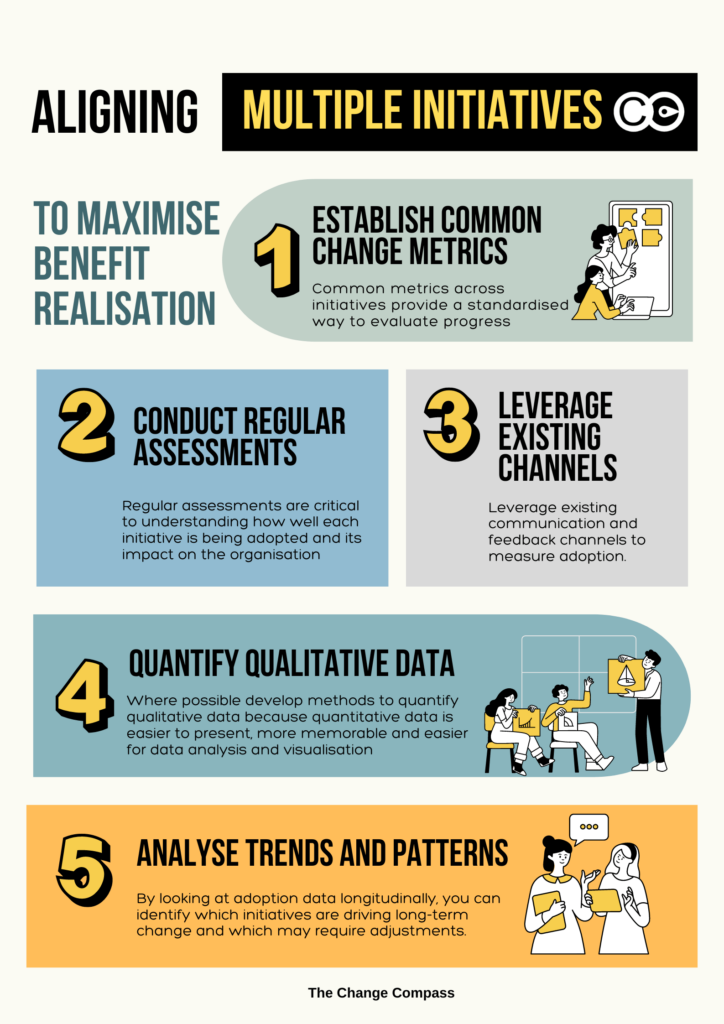
2. Conduct Regular Assessments
Regular assessments are critical to understanding how well each initiative is being adopted and its impact on the organisation. These assessments should be scheduled at key milestones and involve both quantitative and qualitative evaluation.
- Pulse Surveys: Conduct pulse surveys at regular intervals to gauge employee sentiment and engagement with each initiative. These short, focused surveys can provide real-time insights into how changes are being received and where additional support may be needed. However do note that pulse survey in themselves may only provide very superficial insights without the depth that may be required to understand the ‘why’ or ‘how’.
- Performance Reviews: Where possible integrate change adoption metrics into regular performance reviews. This ensures that the impact of initiatives is continuously monitored and that any issues are addressed promptly.
- Change Audits: Periodically perform change audits to assess the effectiveness of each initiative. This involves reviewing processes, outcomes, and feedback to determine whether the change is being adopted as intended.
3. Leverage Existing Channels
Leverage existing communication and feedback channels to measure adoption. This approach ensures that you are not overloading employees with new processes and allows for seamless integration into their daily routines.
- Employee Feedback Platforms: Utilise platforms already in place, such as intranet forums like Yammer, suggestion inboxes, or regular team meetings, to gather feedback on change initiatives. This feedback can provide valuable insights into adoption levels and potential areas of resistance.
- Usage Analytics: For technology-driven initiatives, use existing analytics tools to monitor system usage and user behaviour. This can help identify adoption rates and areas where additional training or support may be needed.
- Regular Check-ins: Integrate adoption tracking into regular team check-ins. This allows managers to discuss progress with their teams and identify any challenges early on.
4. Quantify Qualitative Data
While quantitative metrics are essential, qualitative data provides context and deeper insights into how changes are being adopted. It’s important to develop methods to quantify this qualitative data to better understand the impact of your initiatives. Quantitative data are easier to present, and may be more memorable to your stakeholders.
- Sentiment Analysis: Use sentiment analysis tools to analyse employee feedback, comments from surveys, or even social media mentions. This helps quantify the overall sentiment towards each initiative, providing a clearer picture of adoption.
- Focus Groups: Conduct focus groups to gather in-depth feedback on specific initiatives. While this data is qualitative, you can quantify it by categorizing responses into themes and measuring the frequency of each theme.
- Narrative Metrics: Develop narrative metrics that capture the stories behind the numbers. For example, if an initiative aims to improve customer service, track success stories where employees went above and beyond as a result of the new changes.
5. Analyse Trends and Patterns
Analysing trends and patterns over time is essential for understanding the broader impact of multiple initiatives. By looking at adoption data longitudinally, you can identify which initiatives are driving long-term change and which may require adjustments.
- Adoption Trajectories: Track the adoption trajectories of each initiative. Are there certain initiatives that show rapid early adoption but then plateau? Understanding these patterns can help refine strategies to sustain momentum.
- Cross-Initiative Analysis: Compare adoption trends across different initiatives. Look for correlations or conflicts between initiatives. For example, if one initiative shows strong adoption while another lags, investigate whether they are competing for the same resources or if there is confusion about priorities.
- Predictive Analytics: Use predictive analytics to forecast future adoption trends based on historical data. This can help in proactive decision-making and resource allocation. This is absolutely the value of data, when you have historical data you can easily forecast what lies ahead and provide an overlay for change portfolio consideration during business planning cycles.
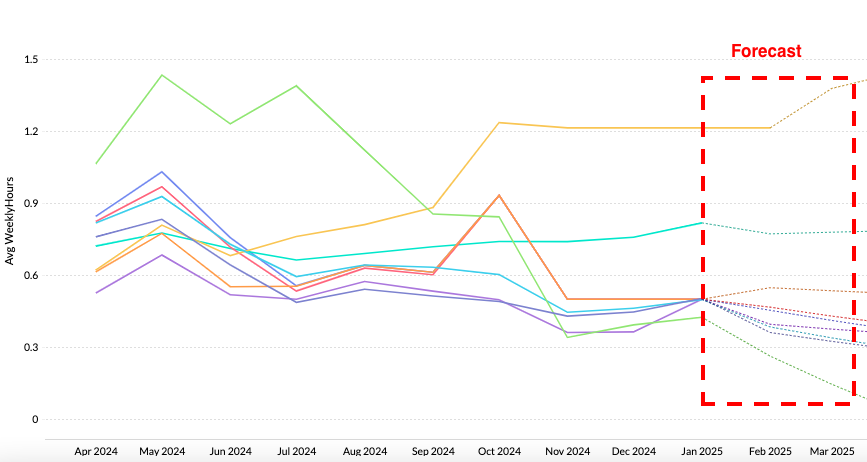
6. Communicate Progress Transparently
Transparent communication is vital for building trust and ensuring that everyone in the organization is aware of the progress of each initiative. This helps in aligning efforts and maintaining momentum.
- Regular Updates: Provide regular updates on the progress of each initiative. Use a variety of channels such as newsletters, town halls, or internal social media to keep everyone informed.
- Success Stories: Share success stories that highlight the benefits of adoption. This not only celebrates achievements but also reinforces the value of the initiatives and encourages further adoption.
- Dashboard Reporting: Develop a dashboard that tracks and displays adoption metrics for all initiatives in real-time. Make this dashboard accessible to key stakeholders to ensure transparency and accountability.
7. Establish a Governance Framework
A governance framework is essential for coordinating multiple initiatives and ensuring that they are aligned with the organization’s strategic goals. This framework should provide structure, oversight, and guidance for all change efforts.
- Steering Committees: Establish steering committees composed of senior leaders who oversee the progress of all initiatives. These committees should ensure that initiatives are aligned with business objectives and that resources are appropriately allocated.
- Change Champions: Identify change champions within the organization who can advocate for adoption and provide support to their peers. These individuals play a crucial role in driving change from within and ensuring alignment across initiatives, similar to a strong leadership team.
- Standardised Processes: Develop standardized business processes for planning, implementing, and measuring change initiatives. This ensures consistency and allows for more effective comparison and integration of efforts. In establishing the right routines they become embedded within business practices and are not seen as an ‘additional effort required’ on top of their day-jobs.

Aligning Multiple Initiatives for Maximum Business Benefit
While measuring adoption is crucial, aligning multiple initiatives to maximize business benefits is the ultimate goal. Here are key strategies to ensure alignment:
1. Prioritise Initiatives Based on Strategic Value
Not all initiatives are created equal. Prioritising initiatives based on their strategic value ensures that resources are allocated effectively and that the most critical changes receive the attention they deserve.
- Value Assessment: Conduct a value assessment for each initiative to determine its potential impact on the organization’s strategic goals. Focus on initiatives that align most closely with these goals.
- Resource Allocation: Allocate resources based on the strategic value of each initiative. This may involve dedicating more resources to high-priority initiatives while scaling back on others.
- Phased Implementation: Consider implementing high-priority initiatives in phases. This allows you to focus efforts on achieving quick wins, which can build momentum for broader change.
These are just a few points within the whole area of change portfolio management that are critical when you are managing across initiatives. To read more about change portfolio management check out our other articles here.
2. Integrate Change Initiatives
Integration of change initiatives is essential to avoid duplication of efforts and to ensure that all initiatives are working towards common goals. This requires a coordinated approach and effective communication across initiatives and stakeholders.
- Change Integration Plan: Develop a change integration plan that outlines how different initiatives will work together. This plan should identify potential overlaps and ensure that all initiatives are aligned. It could be that lower prioritised initiatives be pushed out making the runway for more strategic initiatives with higher priorities. It could also be ‘packaging’ change releases across different initiatives where they make sense to deliver change to the impacted teams in a more cohesive and easier-to-digest manner, similar to a comprehensive change management plan. This may be due to the nature of the changes or the volume and capacity required in the impact of the changes.
- Cross-Functional Teams: Establish cross-functional teams to oversee the integration of initiatives. These teams should include team members who are representatives from each initiative to ensure collaboration and alignment. Ideally, cross-functional forums already exist and this is just tapping into an existing channel.
- Unified Communication Strategy: Create a unified communication strategy that aligns messaging across initiatives. This helps avoid confusion and ensures that employees receive consistent information. To do this, data is required to be able to have a clear view in terms of communication content and planned releases.
3. Monitor and Adjust in Real-Time
The business environment is dynamic, and change initiatives need to be adaptable. Monitoring progress in real-time and being willing to adjust strategies is crucial for success. At a minimum, set up routine reporting timelines so that data and reporting are harmonised and embedded within the operating rhythms of those involved.
- Real-Time Monitoring: Use real-time data to monitor the progress of each initiative within the change process. This allows you to identify issues early and make adjustments as needed.
- Agile Approach: Adopt an agile approach to change management, where initiatives are continuously reviewed and adjusted based on feedback and changing circumstances.
- Flexibility in Execution: Be prepared to pivot if an initiative is not delivering the expected results or needs to be adjusted based on the challenges of impacted business teams. This might involve reallocating resources, adjusting timelines, or even pausing initiatives that are not aligned with current business needs.
Successfully managing and aligning multiple change initiatives is a complex but achievable task. By establishing common metrics, conducting regular assessments, leveraging existing channels, and quantifying qualitative data, you can effectively measure adoption. Aligning initiatives for maximum business benefit requires prioritisation, integration, and real-time monitoring. For change management practitioners and leaders, these strategies are essential for driving organisational success in a world of increased rate of change. By strategically aligning multiple initiatives, you can ensure that the organisation not only adapts to change but thrives in it.
To read more about managing change adoption check out The Comprehensive Guide to Change Management Metrics for Adoption.
Though not elaborated, what is inherent in this article is the importance of behaviour in adoption, understanding it, and measuring it. To read more about driving behaviour change check out The Ultimate Guide to Behaviour Change.




